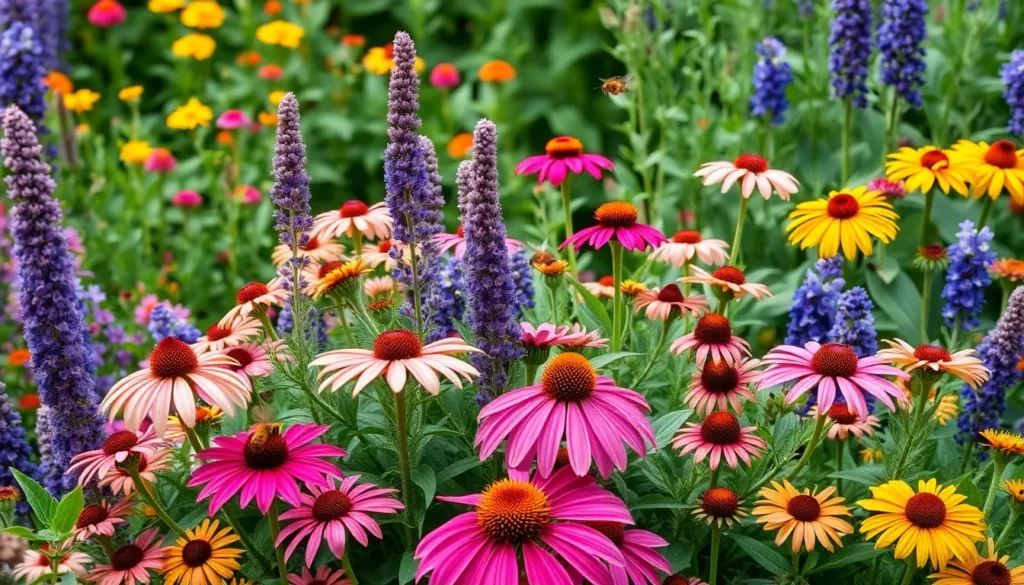Gardening is a joyful dance with nature, where every bloom invites a world of vibrant life to your doorstep. Whether you’re just starting out or have seasoned hands in the soil, embracing the art of attracting pollinators transforms your garden into a bustling hub of growth and beauty. This guide, “15 Best Attracting Pollinators To Your Garden,” is crafted to elevate your gardening experience and empower you with the knowledge to make your garden a pollinator’s paradise.
Unlocking the secrets to drawing in bees, butterflies, and other essential pollinators is not only a pleasure but a crucial step in fostering a thriving ecosystem. With these practical tips and techniques, you’ll gain the confidence to create a garden that buzzes with life and rewards you with bountiful harvests. Let’s embark on this exciting journey together, celebrating the symbiotic relationship between gardener and nature, and watch your garden flourish like never before.
Bee Balm (Vibrant Blooms for Bees and Hummingbirds)
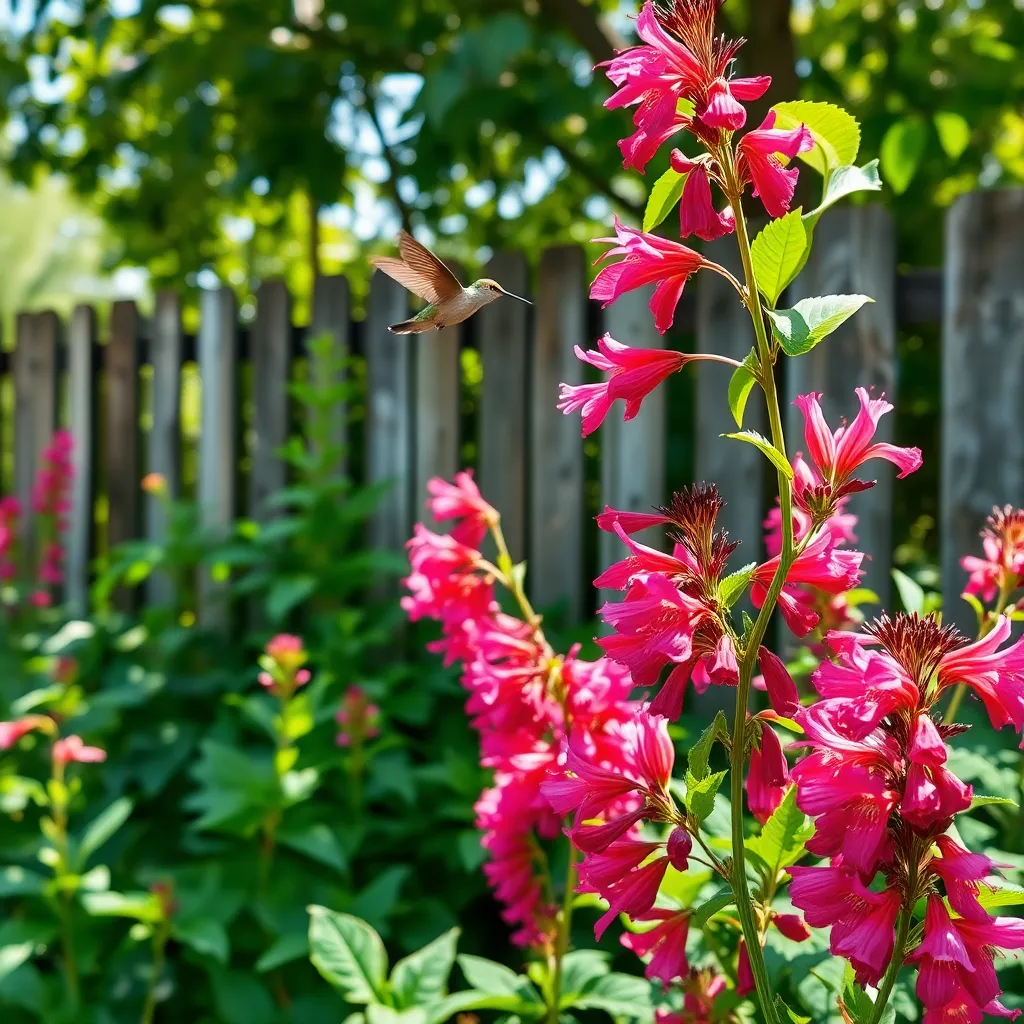
Bee balm, known for its vibrant and fragrant blooms, is a favorite among pollinators like bees and hummingbirds. To grow bee balm successfully, plant it in a sunny location with rich, well-drained soil that retains some moisture.
For best results, ensure the soil is slightly acidic to neutral, with a pH of 6.0 to 7.0. Regular watering is important, especially during dry spells, to keep the soil consistently moist but not waterlogged.
Deadheading the spent blooms will encourage more flowering throughout the season, keeping your garden colorful and buzzing with life. If you want to keep bee balm looking tidy, cut back the stems to the ground in late fall after the first frost.
While beginners will find bee balm easy to grow, experienced gardeners can experiment with different cultivars to discover a range of colors from pink to deep red. Consider dividing the plants every 2-3 years to maintain vigor and prevent overcrowding, which can help minimize the risk of powdery mildew.
Butterfly Bush (Fragrant Nectar for Butterflies)

The Butterfly Bush, known scientifically as Buddleja, is a magnet for butterflies, making it a delightful addition to any garden aiming to attract pollinators. This plant thrives in full sun and well-drained soil, rewarding gardeners with fragrant blooms that persist from summer into fall.
Ensure your Butterfly Bush receives at least six hours of sunlight daily for optimal growth and flower production. Water the plant deeply and infrequently, allowing the soil to dry between waterings to prevent root rot.
Pruning is essential to keep your Butterfly Bush healthy and encourage more prolific blooming. In late winter or early spring, cut back the plant to about one-third of its size, which helps control its size and rejuvenates the plant.
For those looking to enhance their gardening skills, consider experimenting with different cultivars like ‘Black Knight’ or ‘Nanho Blue’ to add variety and color. These varieties not only attract butterflies but also add a beautiful range of hues to your garden, from deep purples to soft blues.
Native Wildflower Mix (Region-Specific Pollinator Magnet)
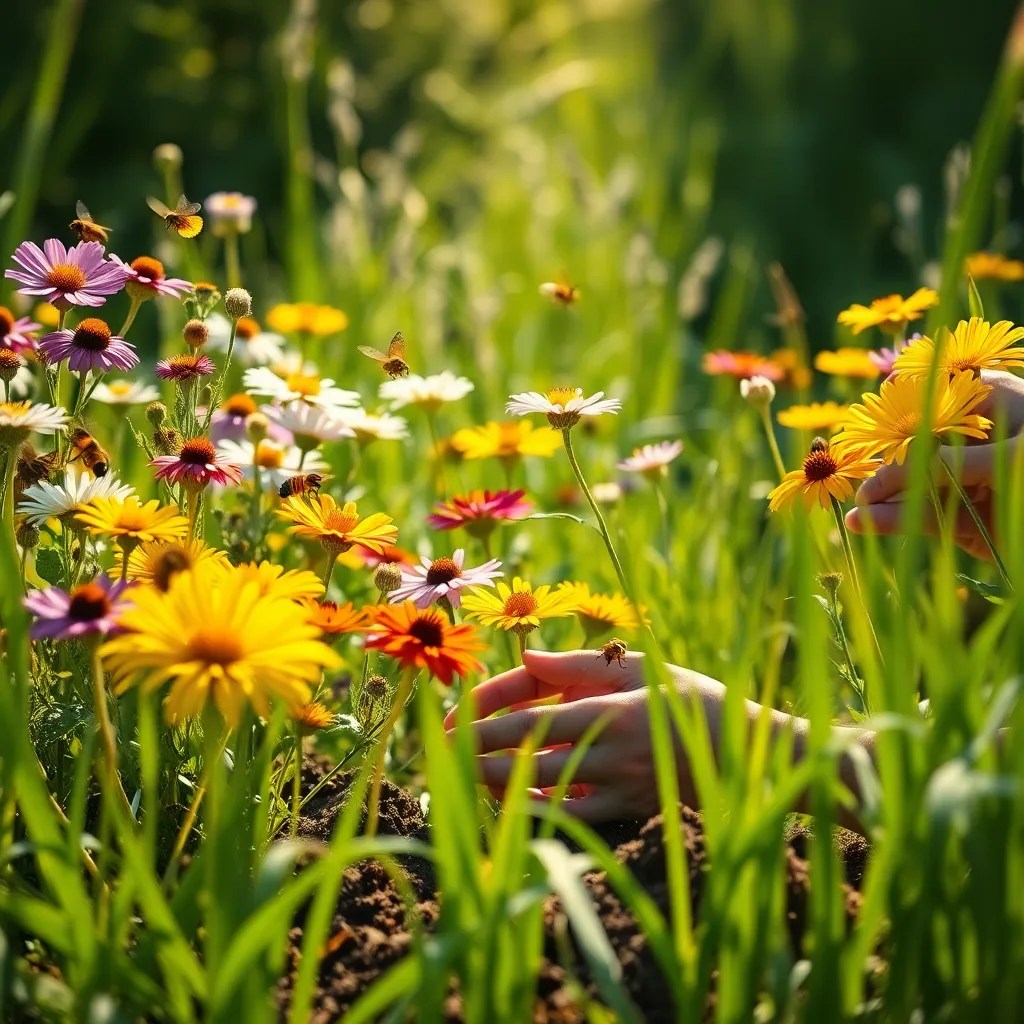
Native wildflower mixes are a fantastic way to attract pollinators while providing a splash of color to any garden. To create a successful wildflower patch, it’s essential to select a mix that is specific to your region, ensuring that the plants are suited to the local climate and soil conditions.
Begin by choosing a sunny location, as most wildflowers thrive in full sunlight. Prepare the soil by removing any existing weeds and loosening it with a garden fork; wildflowers are hardy but will establish more quickly in well-aerated soil.
Once the soil is ready, scatter seeds evenly across the prepared area. Cover the seeds lightly with soil or compost, ensuring good seed-to-soil contact, which is crucial for successful germination.
Water the seeded area gently but thoroughly after sowing, and continue to keep the soil moist for the first few weeks. As the plants grow, they will require less frequent watering, thriving on natural rainfall in most cases, but additional watering during dry spells will help ensure robust growth.
For a beginner, it might be helpful to start with an all-purpose wildflower seed mix. However, more experienced gardeners might enjoy experimenting by creating their own custom mix, carefully selecting species to enhance biodiversity and target specific pollinators.
To maintain the health of your wildflower garden, consider cutting back the plants in late autumn after they have gone to seed. This not only tidies the garden but also helps distribute seeds naturally, encouraging self-seeding and a more vibrant display the following season.
Pollinator-Friendly Water Feature (Hydration Station)
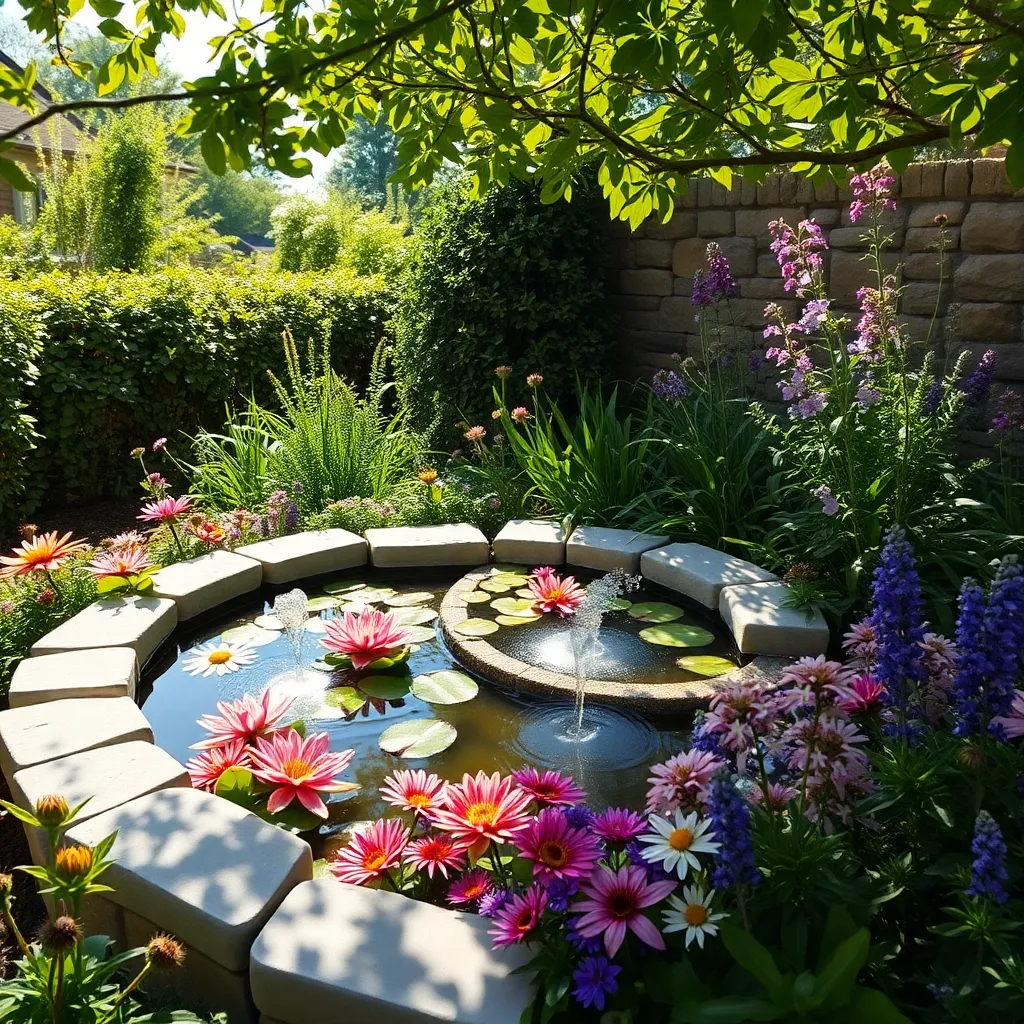
Creating a pollinator-friendly water feature in your garden can significantly enhance its appeal to butterflies, bees, and birds. These hydration stations provide much-needed water, especially during hot, dry spells when natural sources are scarce.
Start by choosing a shallow dish or birdbath that allows easy access for small pollinators. Ensure the water feature is no more than two inches deep to prevent drowning and add a few flat stones or marbles for perches.
It’s crucial to keep the water fresh and clean to attract pollinators effectively. Change the water every two to three days to prevent stagnation and deter mosquitoes.
For added benefit, consider placing the water feature near pollinator-friendly plants like lavender or salvia. This strategic positioning will encourage pollinators to visit both the water and the plants, enhancing pollination in your garden.
Milkweed (Essential for Monarch Butterflies)

Milkweed is a vital plant for attracting monarch butterflies to your garden, as it serves as the exclusive food source for their caterpillars. To successfully grow milkweed, choose a sunny location and plant in well-drained soil, as these conditions mimic its natural habitat.
Begin by selecting a variety of milkweed that is native to your region, such as Asclepias tuberosa or Asclepias incarnata. This ensures better adaptability and supports local pollinator populations more effectively.
Water newly planted milkweed regularly until it is established, typically within the first growing season. Once mature, milkweed is drought-tolerant, requiring only minimal watering, making it a low-maintenance addition to your garden.
For advanced gardeners, consider starting milkweed from seed by stratifying them in the refrigerator for 30 days to enhance germination rates. After planting, monitor the plants for aphids, which can be managed by gently spraying with water or introducing beneficial insects like ladybugs.
Lavender (Aromatic Attractant for Bees)
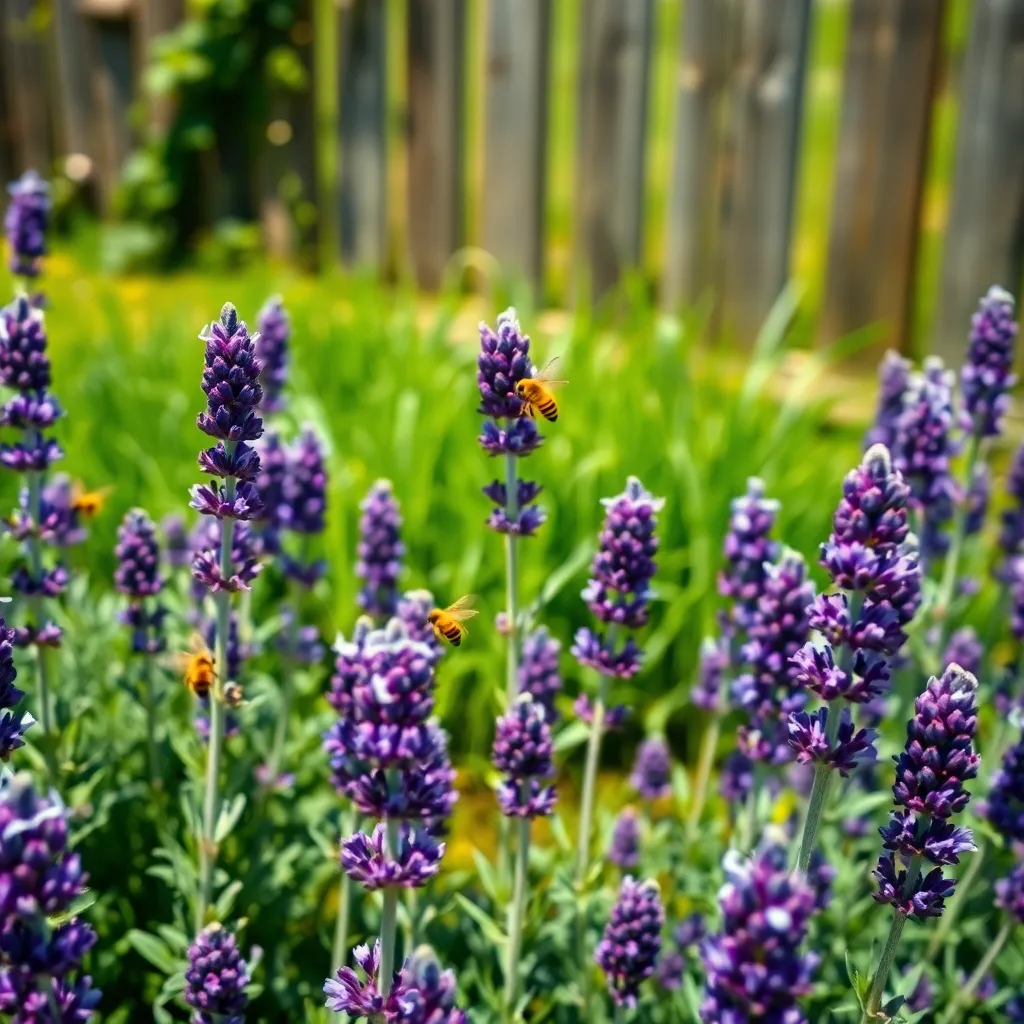
Lavender is a delightful addition to any garden, known for its aromatic blooms that attract a variety of pollinators, especially bees. To thrive, lavender requires well-drained soil and a location with ample sunlight, ideally receiving at least six hours of direct sun each day.
Plant lavender in areas with good air circulation to prevent fungal diseases, which can be a concern in humid climates. Use a garden fork or tiller to improve the soil structure if needed, incorporating sand or grit to enhance drainage, particularly in clay-heavy soils.
Water newly planted lavender regularly during its first growing season to establish a robust root system. Once established, lavender is drought-tolerant and generally requires watering only when the top inch of soil is dry, making it a low-maintenance choice for busy gardeners.
For more vibrant blooms, consider pruning lavender annually in early spring. Trim about one-third of the plant’s height to encourage bushier growth and more prolific flowering, ensuring your garden remains a buzzing haven for bees.
Herb Spiral Garden (Multi-Layered Pollinator Haven)
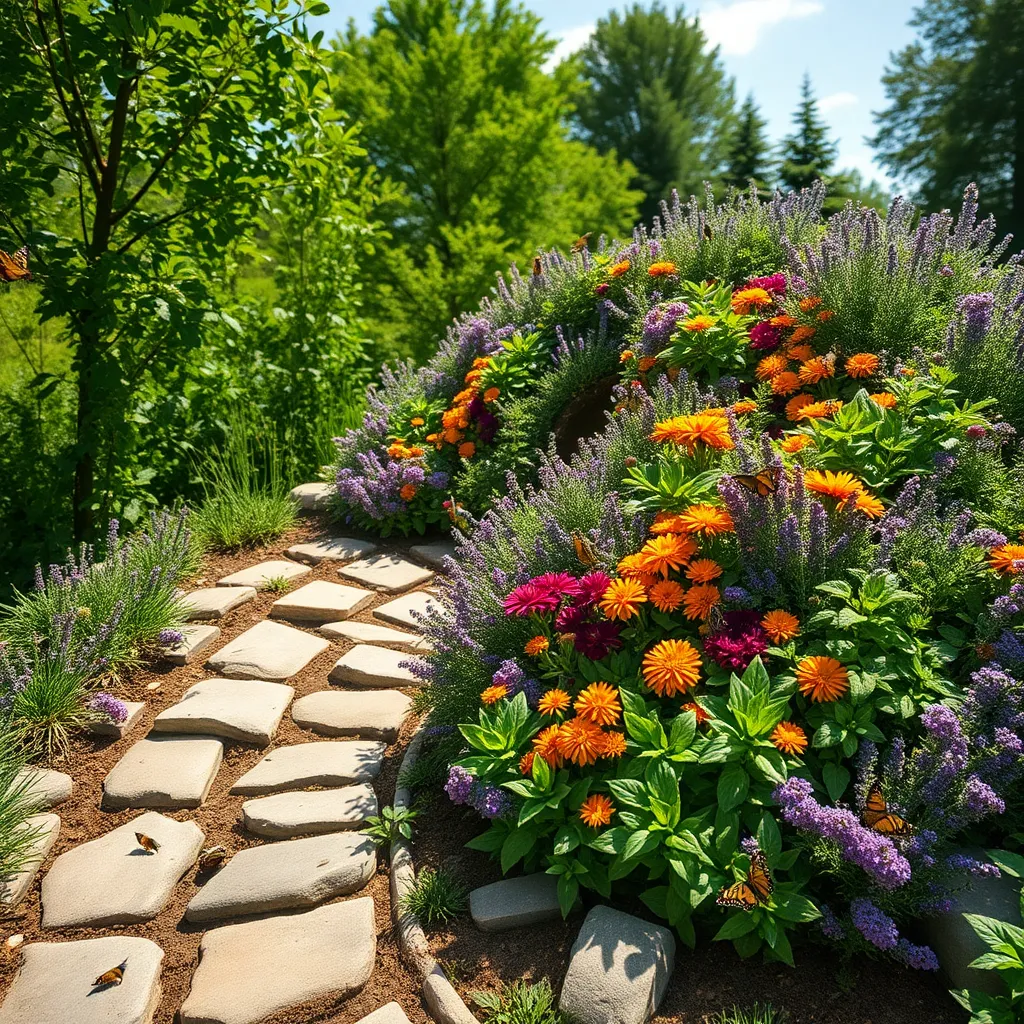
Creating a herb spiral garden is a fantastic way to attract pollinators while maximizing space in your garden. This design uses a spiral shape to create multiple microclimates, allowing you to grow a variety of herbs that cater to different pollinator preferences.
To construct a herb spiral, start by selecting a sunny spot in your garden—ideally one that receives at least six hours of sunlight per day. Use rocks, bricks, or any solid material to form the spiral structure, ensuring it is stable and well-drained.
Fill the base with nutrient-rich soil, making sure to amend with compost to provide a healthy growing medium. As you build upwards, incorporate more sandy soil at the top to suit herbs like rosemary and thyme that prefer drier conditions.
Place moisture-loving herbs like mint and parsley at the bottom where water naturally accumulates. Meanwhile, plant drought-tolerant herbs such as oregano and sage at the top to benefit from the drier environment.
Water your herb spiral regularly, but be mindful of the different water needs at various levels. As herbs bloom, they will attract a variety of pollinators, making your garden a buzzing hub of activity.
Hummingbird Feeder (Nectar-Rich Attraction)
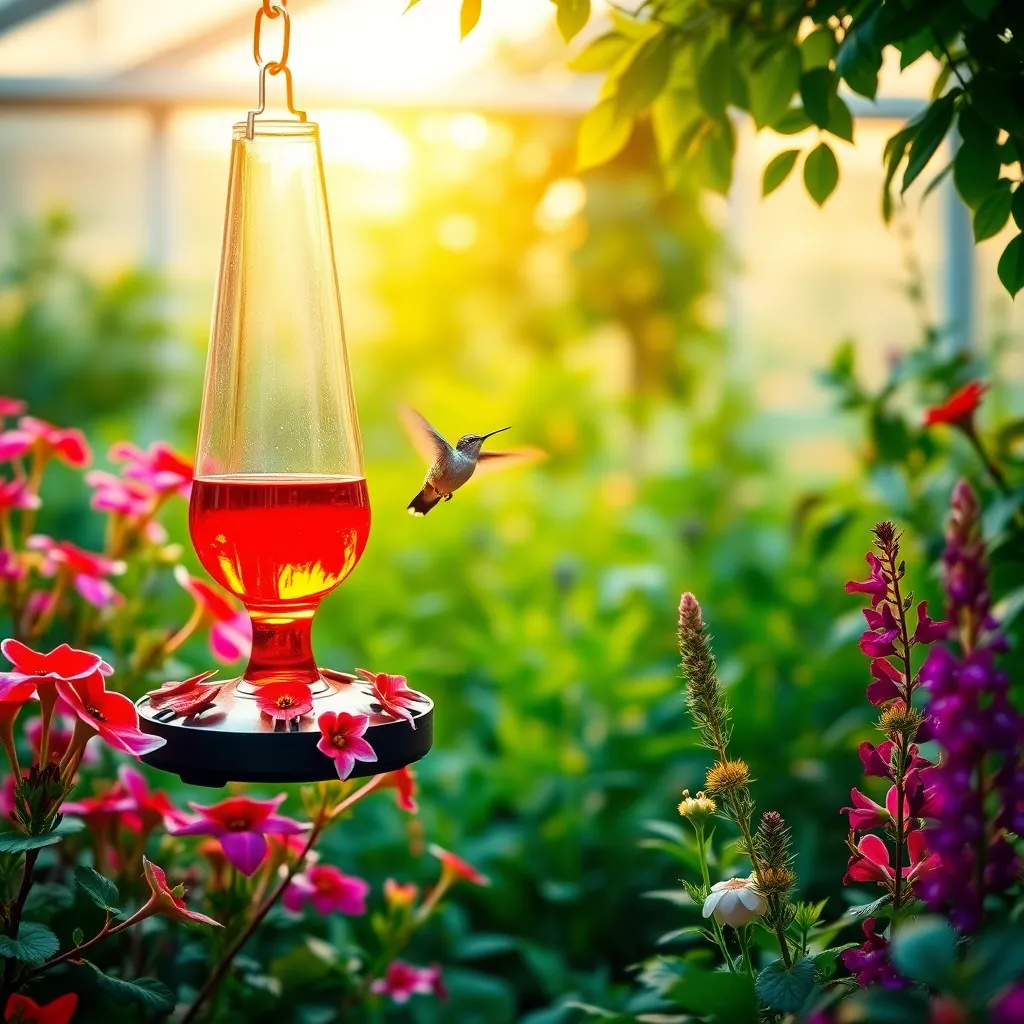
Adding a hummingbird feeder to your garden is a delightful way to attract these vibrant pollinators. Fill your feeder with a simple homemade nectar solution of four parts water to one part white granulated sugar, boiling the mixture to ensure the sugar dissolves completely.
Place the feeder in a shaded area to prevent the nectar from fermenting quickly and to provide a cool resting spot for hummingbirds. Clean the feeder at least once a week with warm water and vinegar to avoid harmful mold and bacteria buildup.
For those looking to attract more hummingbirds, consider planting nectar-rich flowers such as bee balm, salvia, and trumpet vine nearby. These plants not only supply additional natural nectar sources but also enhance the visual appeal of your garden with their vibrant blooms.
Experiment with different feeder designs to see which attracts the most visitors to your garden. Some gardeners find that feeders with bright red bases are particularly effective, as hummingbirds are naturally drawn to this color.
Organic Mulch (Soil Health Enhancer and Insect Habitat)

Organic mulch serves as a dual-purpose powerhouse in your garden, enhancing soil health while creating habitats for beneficial insects. By using materials like shredded leaves, straw, or bark chips, you can improve soil moisture retention and suppress weeds, which is crucial for a thriving garden ecosystem.
For beginners, start by applying a 2-3 inch layer of mulch around your plants, ensuring you keep the mulch a few inches away from the plant stems to prevent rot. Advanced gardeners can experiment with different types of organic mulch, such as pine needles or cocoa hulls, to see which best suits their garden’s needs and aesthetics.
Organic mulch not only nourishes the soil but also provides shelter for essential garden allies like beetles and earthworms, which help aerate the soil and break down organic matter. To encourage a diverse insect habitat, consider leaving small areas of bare soil between mulch patches to allow ground-nesting pollinators access to nesting sites.
Incorporating organic mulch is a straightforward process that can be done at any time of the year, though it’s particularly beneficial to apply it in the spring and fall. Regularly replenish the mulch as it decomposes, turning it into rich, dark humus that improves soil structure and fertility over time.
Coneflower (Long-Blooming Pollinator Favorite)
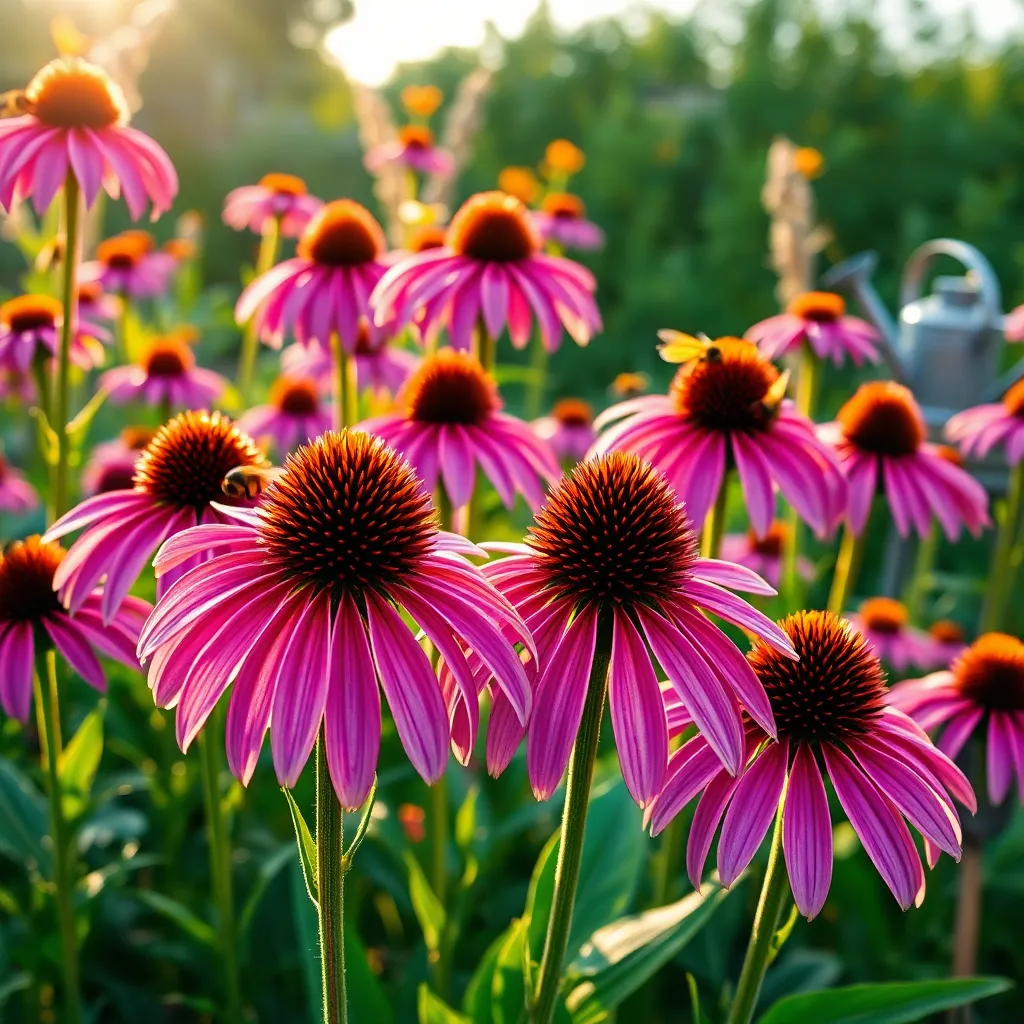
Coneflowers, also known as Echinacea, are renowned for their vibrant blooms and ability to attract pollinators. These hardy perennials flourish in USDA zones 3 to 9, making them a versatile choice for many gardeners.
For optimal growth, plant coneflowers in an area that receives full sun, as they thrive best with at least 6 hours of direct sunlight daily. Ensure the soil is well-draining, as coneflowers are susceptible to root rot if left in overly moist conditions.
Watering should be done moderately, allowing the soil to dry out between waterings to mimic their natural prairie habitat. During the first year, provide additional water to establish strong roots, but once mature, coneflowers are quite drought-tolerant.
To encourage more blooms, deadhead spent flowers regularly, which also helps prevent unwanted self-seeding. For experienced gardeners, dividing the plants every 3 to 4 years in early spring can promote healthier growth and more prolific flowering.
Flowering Herbs (Dual Purpose: Culinary and Pollinator Appeal)
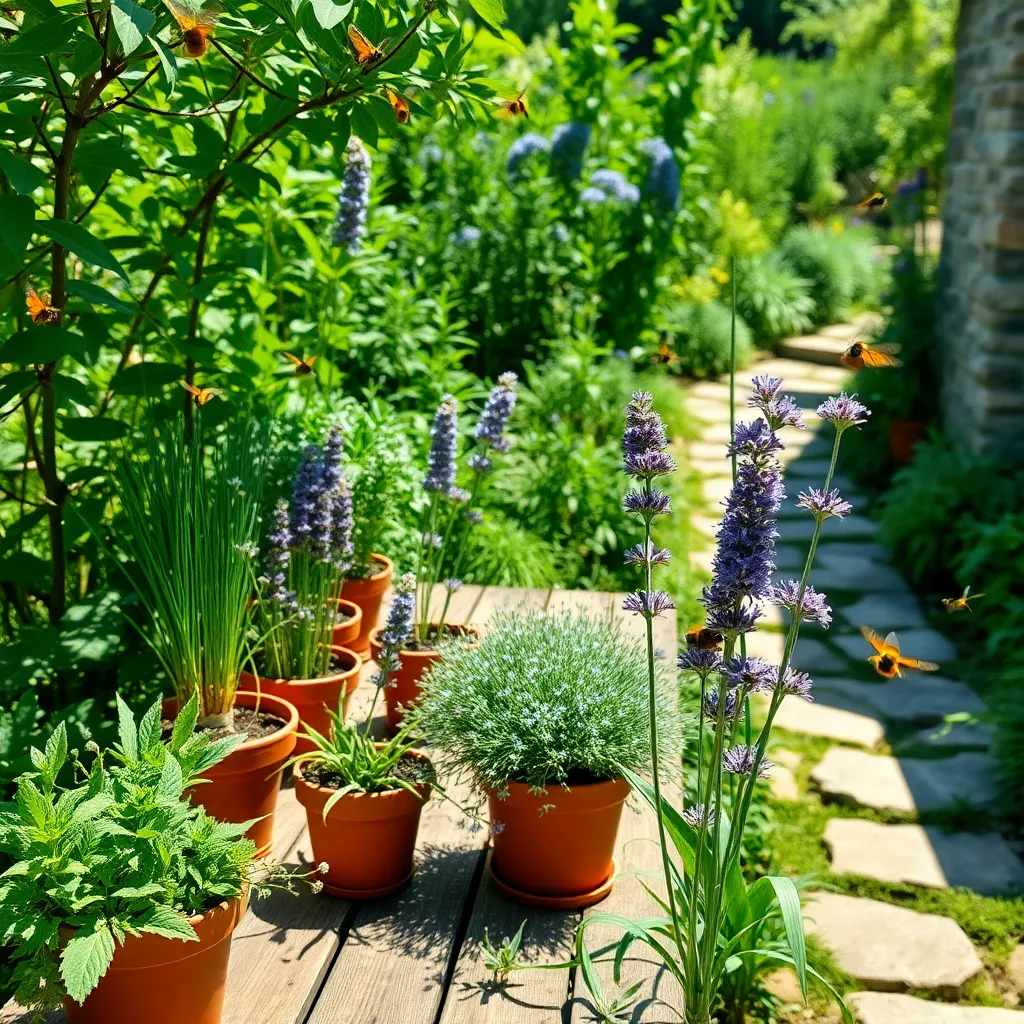
Herbs like lavender, basil, and chives are more than just culinary delights; they also play a significant role in attracting pollinators to your garden. Lavender, with its fragrant purple blooms, is a magnet for bees and butterflies while adding a delightful aroma to your outdoor space.
Growing these herbs requires attention to specific conditions to thrive. Lavender prefers well-draining, sandy soil and thrives in full sun, making it an ideal choice for sunny borders or raised beds.
Basil is another dual-purpose herb that provides both flavor and pollinator appeal. For best results, plant basil in nutrient-rich soil, keep it consistently moist, and pinch back the flowers to encourage leaf production and a bushier plant.
Chives, with their delicate purple flowers, not only attract bees but also repel pests like aphids from neighboring plants. Ensure chives are planted in rich, well-drained soil and receive regular watering to maintain their growth and attractive blooms.
To maximize the benefits of these flowering herbs, consider planting them in clusters or alongside other pollinator-friendly plants. This strategy not only enhances the visual appeal but also increases the likelihood of attracting a diverse range of pollinators to your garden.
Sunflower (Seed and Nectar Source for Birds and Bees)
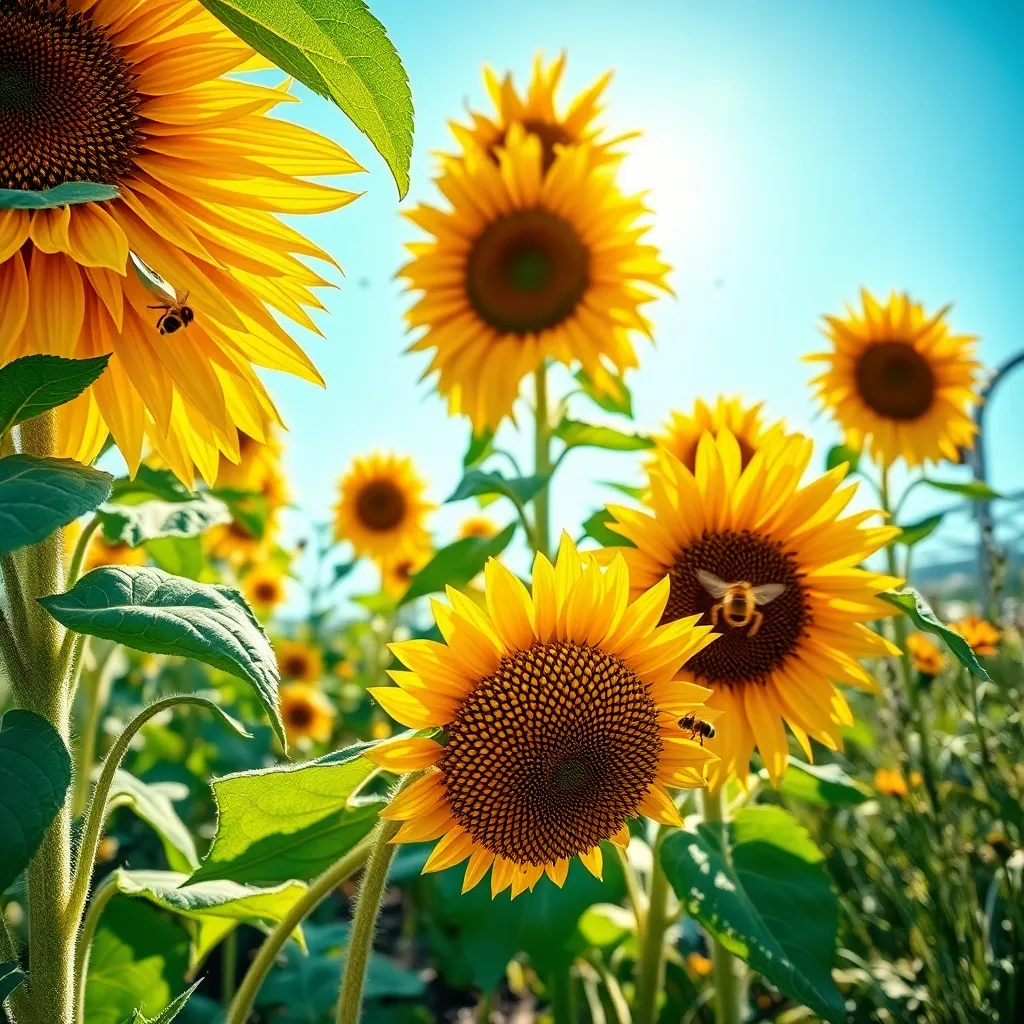
Sunflowers are a fantastic addition to any garden, offering both beauty and function by attracting pollinators like birds and bees. These vibrant plants are not only a stunning visual treat but also provide a rich source of nectar and seeds that help sustain wildlife.
To successfully grow sunflowers, choose a sunny spot in your garden, as they thrive in full sunlight. Plant seeds directly into well-draining soil enriched with compost to give them the nutrients they need for robust growth.
Water the sunflowers consistently but avoid overwatering, especially during the early growth stages. Once established, these hardy plants are quite drought-tolerant, making them an excellent low-maintenance choice for busy gardeners.
For those interested in more advanced gardening, consider planting a variety of sunflower species to stagger blooming times and extend the feeding period for pollinators. Taller varieties can also be used as natural supports for climbing plants, creating a dynamic and interactive garden landscape.
Vertical Garden Wall (Space-Saving Pollinator Habitat)
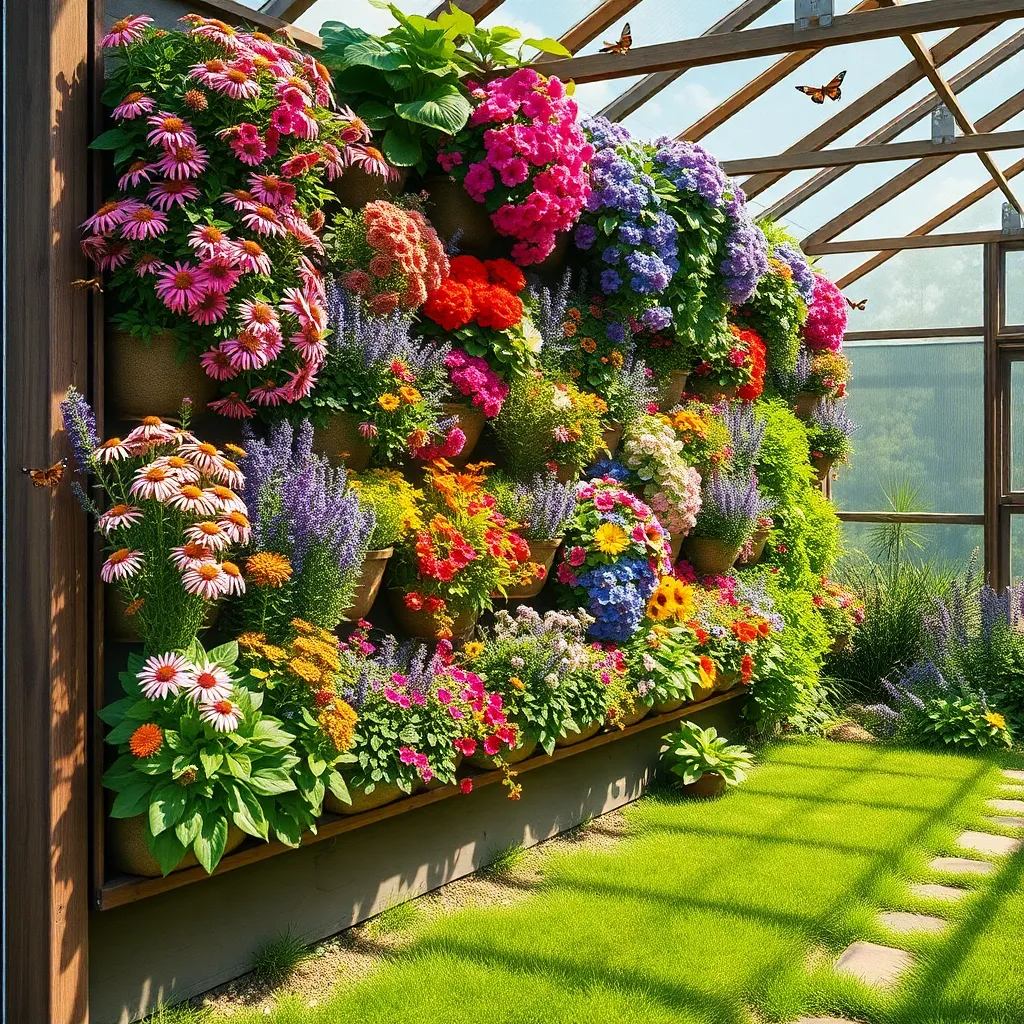
Transform your garden into a vibrant, vertical paradise by creating a vertical garden wall that doubles as a space-saving pollinator habitat. This technique is ideal for gardeners with limited ground space but who still want to attract a variety of pollinators like bees, butterflies, and hummingbirds.
Start by selecting a sturdy frame or trellis that can support the weight of soil and plants. Opt for lightweight planters or pockets that can be easily attached to the frame, ensuring they have adequate drainage to prevent root rot.
Choose plants that are known to attract pollinators and can thrive in vertical settings, such as nasturtiums, lavender, and creeping thyme. These plants not only provide nectar-rich flowers but also offer varying heights and textures, creating an inviting habitat for pollinators.
Ensure your vertical garden receives adequate sunlight, as most pollinator-friendly plants require at least six hours of sun daily. Watering needs will vary depending on your plant selection, but a general rule is to keep the soil consistently moist without oversaturating it.
For advanced gardeners, consider integrating an automatic drip irrigation system to maintain consistent moisture levels. Additionally, incorporate perennial plants that return each year, reducing the need for replanting and offering a stable food source for pollinators.
Fruit Trees (Blossom and Nectar Provider)
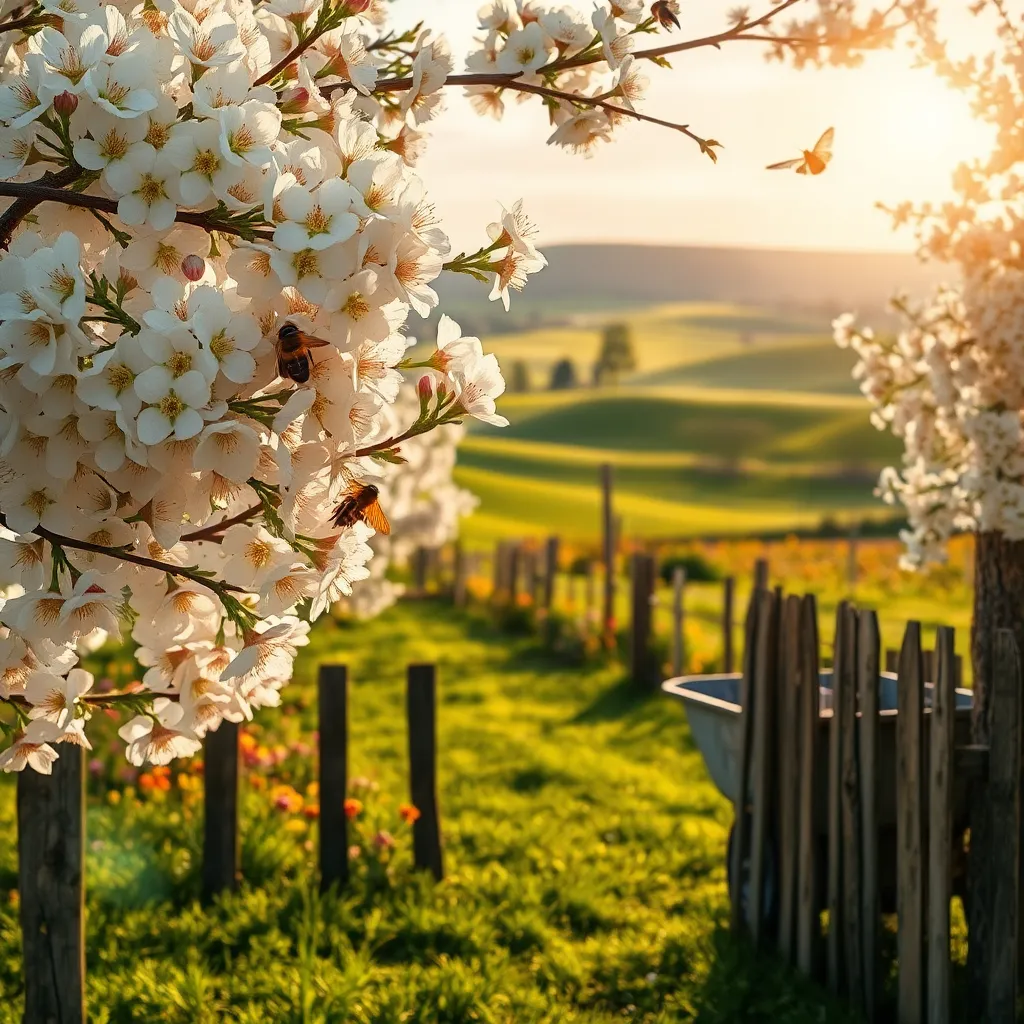
Fruit trees are an excellent way to attract pollinators while delivering a bounty of fresh produce. They provide a dual benefit by offering blossoms rich in nectar for bees, butterflies, and other beneficial insects. Selecting the right type of fruit tree is crucial; opt for varieties known for their abundant blooms like apple, cherry, or pear. These trees not only enhance your garden’s aesthetic but also contribute significantly to the local ecosystem.
When planting fruit trees, consider the specific sunlight and soil requirements for each species. Most fruit trees thrive in well-drained soil with full sun exposure, which maximizes their blooming potential. It’s essential to maintain a consistent watering schedule, especially during the first few years as the tree establishes itself. Deep watering once a week is generally recommended to encourage deep root growth.
For novice gardeners, starting with dwarf or semi-dwarf varieties can be more manageable in terms of space and maintenance. These types are easier to prune and harvest, and they still offer plentiful blooms to entice pollinators. Regular pruning is vital to ensure the tree maintains a healthy shape and promotes better air circulation, which helps in disease prevention. Use sharp, clean tools and remove any dead or crossing branches to keep your tree thriving.
Advanced gardeners might experiment with grafting techniques to enhance fruit production and diversity. Grafting allows you to cultivate multiple varieties on a single tree, which can extend the blossoming period and attract a wider range of pollinators. Ensure you monitor for pests and diseases, implementing organic pest control methods like neem oil or beneficial insects where necessary. This proactive approach helps sustain a healthy and attractive garden environment for pollinators.
Wildlife-Friendly Hedge (Shelter and Food Source for Pollinators)
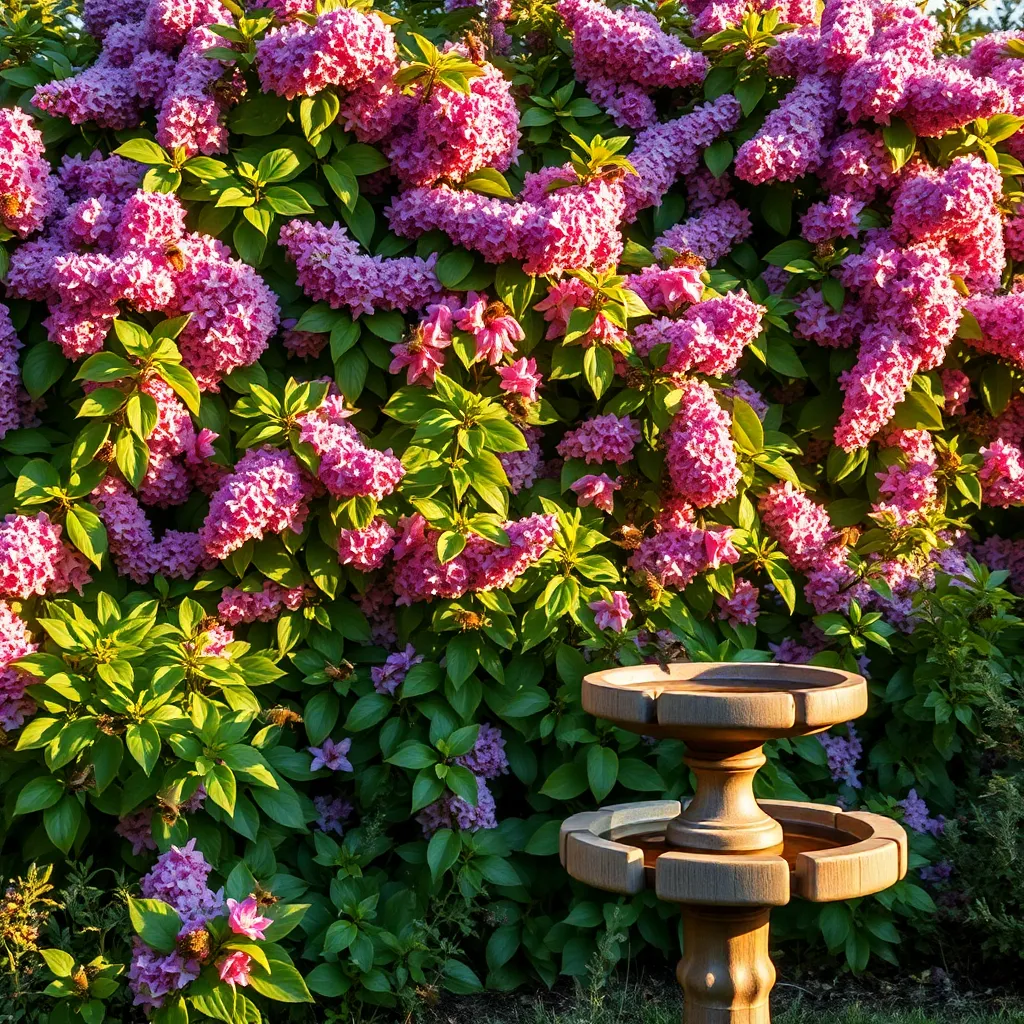
Hedges play an essential role in creating a **wildlife-friendly garden** by providing shelter and food for pollinators. Choosing the right plants is crucial, with options like Hawthorn, Blackthorn, and Wild Privet being excellent choices for attracting bees and butterflies.
Native plants are particularly beneficial as they are **well-adapted to local conditions** and support local wildlife more effectively. Consider planting hedges in well-drained soil and ensure they receive full to partial sunlight for optimal growth.
For those new to gardening, establishing a hedge can be simple by planting young saplings or bare-root plants in a straight line, spaced about 30-60cm apart. Water these young plants regularly, especially during dry periods, to encourage healthy root development.
Experienced gardeners can enhance their hedges by incorporating a mix of flowering shrubs like Dog Rose and Guelder Rose, which bloom at different times of the year. This approach not only extends the **nectar availability** but also adds visual interest to your garden.
Conclusion: Growing Success with These Plants
In nurturing your garden to attract pollinators, you’ve explored 15 essential relationship concepts that mirror the intricacies of human connections. From understanding the power of diversity and creating safe spaces, to the importance of consistency, patience, and offering nourishment, these principles guide both gardens and relationships towards thriving growth. You’ve learned to embrace change, respect boundaries, and recognize the beauty of mutual benefit. These insights do more than just attract bees and butterflies; they foster deeper, more fulfilling human relationships.
Now, take a moment to reflect on these principles and choose one to implement in your personal relationships today. Perhaps start by offering genuine, heartfelt support to someone close or by creating a ‘safe space’ for open communication.
Remember, these concepts are not just for today. Bookmark this article so you can revisit and refresh your approach whenever needed. This simple action ensures you have a valuable resource at your fingertips.
As you apply these insights, envision the blossoming success in your relationships, much like a garden in full bloom. Embrace this journey with optimism and watch your connections flourish and thrive.

